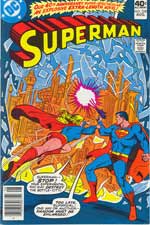 Let
My People Grow!
Let
My People Grow!
In 2009 a very long and ultimately pretty pointless storyline
penned by industry superstars Geoff Johns
and James Robinson saw the Bottle City
of Kandor enlarged on Earth and subsequently relocated to
space, with all sorts of nasty complications for both locales.
Longtime readers may have felt a sense of deja vu -- up
to a point -- as the first epic enlargement of Kandor occured
exactly thirty years earlier in Superman #338 (Aug.
1979). Back then, however, writer Len Wein
went out of his way to avoid all the thorny issues addressed
in 2009's "New Krypton" storyline -- and indeed
any future use of Kandor in any way, shape or form -- when
he wrote "Let My People Grow!"
Illustrated by the legendary Curt
Swan with inks by Frank Chiaramonte,
the story opens with Superman in deep space, sporting an
odd spacesuit and holding up a multi-mirrored contraption
in the heart of an exploding supernova, the better to collect
the flow of "expanding energy" produced by the
once-a-millenium phenomenon.
As he reveals to Supergirl, the plan is
to use the collected "expanding energy" to finally
make good a promise made way back in Action Comics
#242, (July 1958)) by enlarging Kandor, the Kryptonian city
shrunken and placed in a glass bottle by the space villain
Brainiac. At the Fortress of Solitude,
Superman explains his plans to the people of Kandor via
video signal:
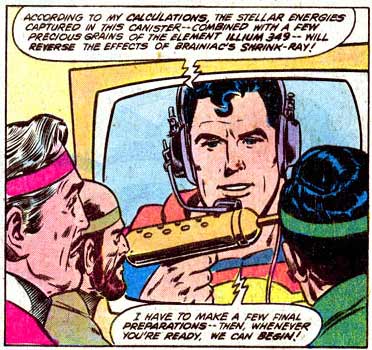
The Kandorians are enthusiastic, with the notable exception
of scientist Arn-Ul, who in a reference
to the classic tale "Superman
in Kandor" notes, "We have attempted to restore
Kandor to normal before...and almost destroyed ourselves!"
Personally, I think it would have worked better to make
this character Than-Ol, the scientist from
that earlier tale, but I admit it's kind of cool Wein called
him "Arn-Ul" since he basically does a Gary
Coleman impression in his scenes here ("What
you talkin' bout, Superman?")
Superman agrees Arn-Ul has some valid concerns and decides
to test the ray on himself before using it on Kandor. The
problem is, in order to be enlarged he must first be shrunk,
and by the same ray that shrank Kandor. That means finding
a way to get Brainiac to shrink him. Superman constructs
a "beeper" attuned to Brainiac's electronic brain
waves, hoping the signal will bring the villain to him.
Now it's a waiting game, so Superman changes to Clark Kent
and puts in an appearance at the Daily Planet offices just
in time for an anniversary party for editor Perry
White.
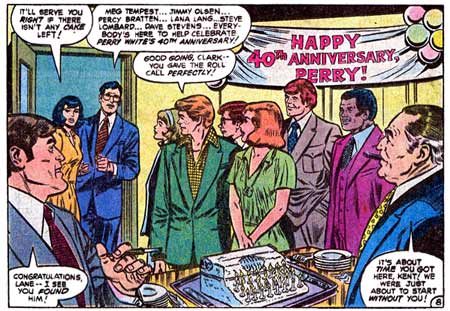
In a neat touch, the cake is shaped like a typewriter (Google
it, kids) with candles for keys. I'm sure the names
of the attendees are supposed to mean something to us, but
today as 30 years ago I'm still mystified by some of them.
Based on comic book tradition, we can at least make some
guesses, however. "Meg Tempest",
for example, would be either the office slut or a soap star
on WGBS (or both). It's a sure bet "Percy Bratten"
is the nebbishy guy with eyeglasses. "Dave
Stevens" of course is the creator of The
Rocketeer, but no one in the room resembles him.
Anyway, an atypically genial Morgan Edge
presents everyone's favorite editor with a solid gold reproduction
of the first story ever to carry his by-line:
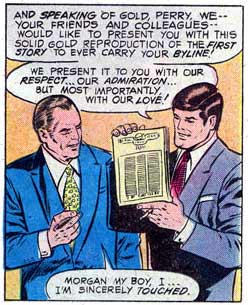
It's a classy gesture, but there is a bit of a catch. You
can't make it out in this panel, but I understand Perry's
first published story ran under the headline, "Disgraced
Cross-Dressing Scoutmaster Brutally Strangled With Own Pantyhose".
Suddenly the building starts shaking, and Clark knows Brainiac
has taken the bait. He switches to Superman and battles
the computer villain in the stratosphere. When Superman
hurls a massive meteoroid at Brainy's saucer, the villain
engages his shrinking ray to reduce the rock to harmless
size. Instead, Superman smashes the meteoroid and takes
the hit from the ray himself.
With Superman reduced to mosquito size, Brainiac tries
to zap him a second time to reduce him "to absolute
nothingness." In desperation, Supergirl fires back
with the enlarging ray, causing the shrink ray to ricochet
back at Brainiac and his ship. As he rapidly shrinks, Brainiac
begs for his life, but Supergirl refuses to use the enlarging
ray on him, saying there isn't enough energy left to save
Superman, Kandor and the villain. Superman too asks Kara
to intervene, but by now it's too late; Brainiac fades to
nothingness.
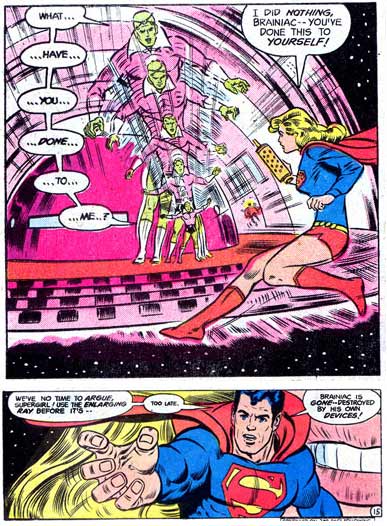
Returning to the Fortress, and with all of Kandor watching
on TV, Supergirl successfully enlarges Superman with the
ray. That settled, the super-cousins offer to enlarge Kandor
on Earth. "After all," as Superman says, "there
isn't a nation that wouldn't welcome you with open arms!"
(Guess he doesn't read Johns and Robinson, either). At this
point, scientist, Superman-lookalike and one-time Nightwing
alter ego Van-Zee pipes up to say no thanks: "One Superman
and Supergirl is enough for any world." The Kandorians
choose instead to colonize a pre-selected, large planet
orbiting a red sun, like good old Krypton. Obligingly, Superman
and Supergirl load Kandor aboard a spaceship and fly it
to the chosen world, enlarging the city in a two-page spread.
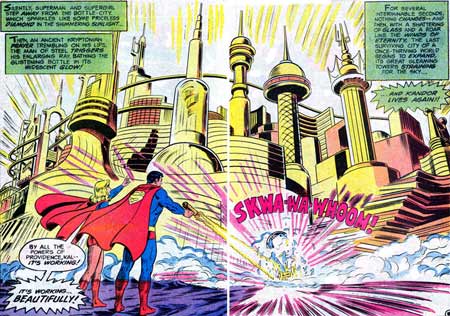
This long-anticipated triumph for Superman is greeted with
jubilation by the Kandorians, who give the super-cousins
a heroes' welcome as they walk down the streets of the restored
last city of Krypton. Kara enjoys a happy reunion with her
parents Zor-El and Alura
(late of Argo City but apparently relocated to Kandor in
a story I must have missed), but the happiness ends when
the city crumbles to dust around its inhabitants.
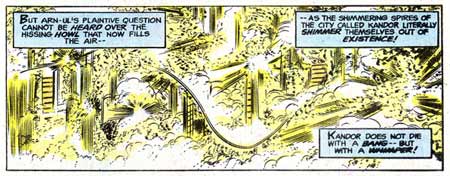
Too late, Superman realizes the enlarging ray works only
on animate objects. Non-living structures, like Kandor's
buildings, lose their molecular adhesion and fall apart.
Superman is disconsolate, blaming himself for Kandor's destruction,
and sourpuss scientist Arn-Ul is only too happy to agree,
delivering a blistering tounge-lashing until Van-Zee tells
him to shut up. This seeming reversal, says Van, may actually
be the best thing that ever happened to Kandor:
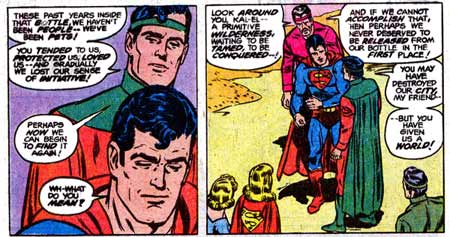
Superman offers to stay and help build this new world,
but Van-Zee responds by knocking him out. As he carries
Superman to the spaceship, Van-Zee explains to Supergirl
that the planet they've chosen is a "phase world"
from another dimension, one which only appears in our universe
during "a shift of the cosmic axis" and which
will be fading away again in mere moments. He sends the
cousins on their way, and our story ends.
Now, I'm not too big on the current "New Krypton"
storyline in Superman comics, but I have to admit that almost
any exploration of the repercussions of Kandor's enlargement
would have to be more interesting than sticking them on
a remote world and having that world disappear. For the
life of me, I've never been able to think of a reason why
Van-Zee and the other Kryptonians should want to remove
themselves from Superman's dimension, except to make him
more unique among Earthlings. And that of course is an editorial
motive, not a character's motive.
In the book, The
Krypton Companion, Wein himself admitted that enlarging
and banishing Kandor closed more doors than it opened, saying
"the idea of bottle city full of tiny people is a much
cooler idea than what I left it as."
I remember being excited about this story back in 1978,
when major, continuity-shaping events happened much more
rarely than they do today, but even at the time I was disappointed
with the ending. It was a miscalculation to think the desire
of readers to see Kandor enlarged was based entirely on
the visual spectacle of the process itself (even in a two-page
spread by Curt Swan). What truly intrigued us about this
giant, lingering "what if" were thoughts of what
might happen AFTER the restoration. Where would you put
thousands of Supermen and what would that mean for the original?
Would they all be good guys? What would happen to the Justice
League in a world where thousands of people outpowered
them? Of course addressing those issues in anything but
an "Imaginary Tale" would have meant changing
the direction of the Super-books entirely, which was out
of the question in 1979 (though it might have been cool
-- and manageable -- to have a far-off world of supermen
to visit every few months. If nothing else, it would have
been easier to get super-enemies from there than breaking
them out of the Phantom Zone all the time).
Maybe more importantly, the shrunken Kandor served as a
living connection to Superman's alien heritage and a potential
seed for Krypton's eventual rebirth. Its presence was at
once a painful reminder that even his powers had limits
and a refuge, a source of solace when his longing for lost
Krypton became acute. In short, I liked it better in the
bottle.
Anyway, somehow this story manages to enlarge Kandor and
make it smaller at the same time.








